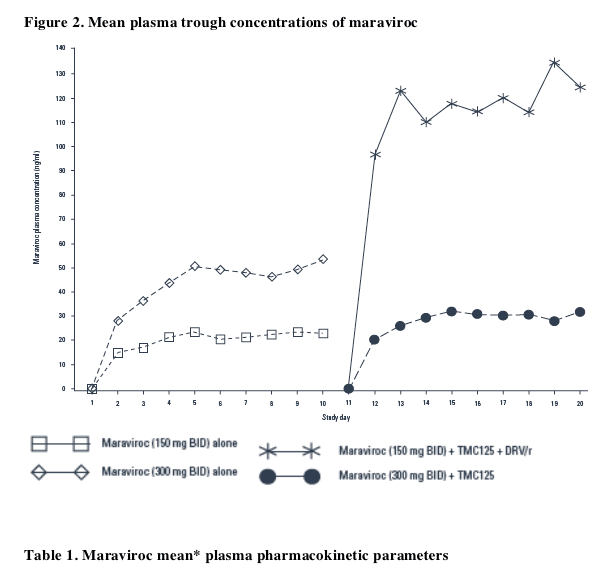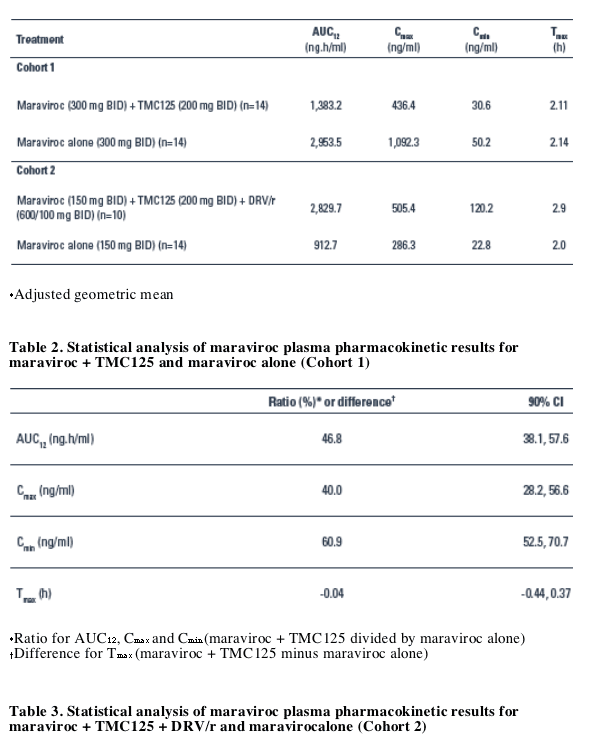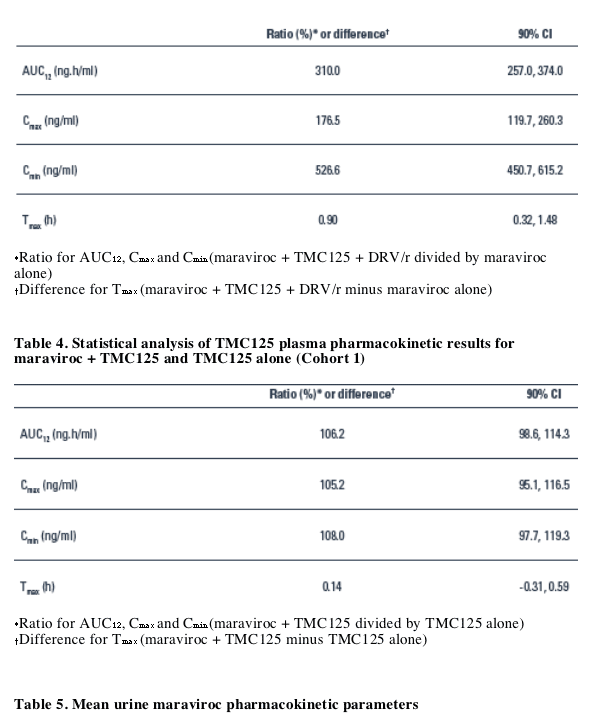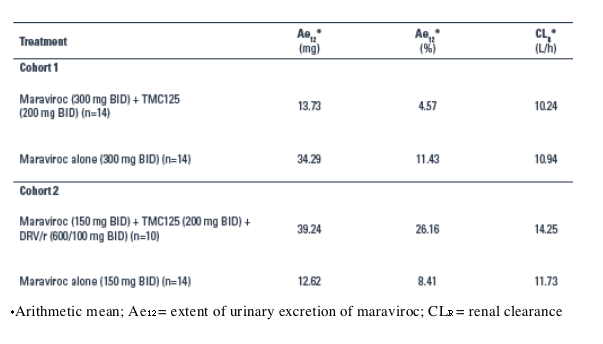 |
 |
 |
| |
An Open, Randomized, Two-Period, Crossover Study in Two Cohorts to Investigate the Effect of Steady-State TMC125 (etravirine) and the Combination of TMC125/Darunavir/Ritonavir on the Steady-State Pharmacokinetics of Oral Maraviroc in Healthy Subjects
|
| |
| |
Reported by Jules Levin
11th European AIDS Conference / EACS
Madrid, Spain, 24-27 October 2007
J Davis1, M Sch_ller-Gyyre2, TN Kakuda3, C Ridgway1, S Tweedy1, N Ndongo4, W Petit4
1Pfizer Global Research and Development, Sandwich, UK; 2Tibotec BVBA, Mechelen, Belgium; 3Tibotec, Inc., Yardley, PA, USA; 4Pfizer Clinical Research Unit, Brussels, Belgium
BACKGROUND
The MOTIVATE 1 and 2 studies showed that combining maraviroc (CELSENTRI¨), a novel CCR5 antagonist, with optimized background therapy significantly enhances virological suppression and the increase in CD4+ cell count in treatment-experienced patients at 48 weeks.1,2 However, co-administration of maraviroc with other drugs carries a risk of drug-drug interactions.
⋅ Preclinical data suggest that maraviroc is a substrate for cytochrome P450 (CYP3A4) and P-glycoproteins (P-gp).3,4 Therefore, modulators of these enzymes/transporters can affect the pharmacokinetics of maraviroc.5,6
⋅ TMC125 (etravirine; developed by Tibotec), a next generation non-nucleoside reverse transcriptase inhibitor, is an inducer of CYP3A4 and has P-gp inhibitory properties. Therefore, TMC125 may reduce maraviroc exposure.
⋅ The protease inhibitor (PI) darunavir (DRV; developed by Tibotec) is a potent inhibitor of CYP3A4 and is co-prescribed with low-dose ritonavir (/r), itself a potent inhibitor and inducer of several cytochrome P450 enzymes and a P-gp inhibitor. When such combinations of inducers and inhibitors are co-administered in humans, the net effect is CYP3A4 inhibition. As such, a 50% dose reduction of maraviroc (i.e. 150 mg BID) is currently recommended in the presence of boosted PIs and other potent CYP3A4 inhibitors.
OBJECTIVES
The primary objectives of this study were to investigate the effects of TMC125 at steady-state on the steady-state pharmacokinetics of maraviroc, either alone or in combination with DRV/r at steady-state, in order to provide optimal dose recommendations for maraviroc when these drugs are co-administered in clinical practice.
Author Summary of findings
⋅ Analysis of maraviroc pharmacokinetics suggests that TMC125 reduces maraviroc exposure but when co-administered with DRV/r, the exposure of maraviroc is increased.
⋅ The exposures of TMC125, DRV and ritonavir were similar to historical data, suggesting maraviroc has no effect on either TMC125 or DRV/r.7-9
⋅ There were few treatment-related adverse events, all of which were mild to moderate in severity, and no clinically significant changes in laboratory tests, vital signs or ECGs
Author Conclusions
⋅ Short-term co-administration of maraviroc with TMC125 and DRV/r was well tolerated and no safety concerns were raised.
⋅ When maraviroc is co-administered with TMC125 in the absence of potent CYP3A4 inhibitors such as boosted Pls (i.e. DRV/r) exposure is reduced and the recommended maraviroc dose is 600 mg BID.
⋅ Maraviroc exposure is increased when co-administered with TMC125 and DRV/r, and as such, the recommended dose of maraviroc is 150 mg BID, consistent with previous reported data for boosted PIs.7
METHODS
⋅ This study was an open, randomized, two-period, crossover study in two cohorts, each of 14 healthy subjects aged 18-55 years. The protocol and informed consent documentation were reviewed and approved by the Independent Ethics Committee and all subjects gave written informed consent.
⋅ For each cohort, the study consisted of:
_ a screening visit up to 28 days before the start of dosing
_ two treatment periods (one lasting 20 days, the other lasting 10 days)
_ a minimum wash-out period of 14 days between treatment periods
_ a follow-up visit 7-10 days after the last dose of study drug.
Cohort 1a (n=7) recd TMC125mg bid for 10 days, then TMC125 200mg bid+ MVC 300mg bid for 10 days. There was a 14-day washout, then MVC 300mg bid.
Cohort 2a (n=7) recd TMC125 200mg bid+ DRV 600/100 mg bid for 10 days, then TMC125 200mg bid+ DRV 600/100mg bid+ MVC 150mg bid. There was a 14-day washout, then MVC 150mg bid.
Cohort 1b (n=7) recd MVC 300mg bid. There was a 14 day washout, then TMC125 200mg bid for 10 days; then, TMC125 200mg bid+ MVC 300mg bid.
Cohort 2b (n=7) recd MVC 150mg bid. There was a 14-day washout, then TMC125 200mg bid+ DRV 600/100mg bid for 10 days; then, TMC125 200mg bid+ DRV 600/100mg bid+ MVC 150mg bid.
⋅ All subjects were fasted for at least 2 hours prior to, and 1 hour after, maraviroc dosing. All TMC125, DRV and ritonavir doses were administered 15 minutes after a standard meal and no more than 5 minutes apart. Subjects were not allowed to consume grapefruit-containing products from 7 days prior to the first dose of study drug until collection of the blood sample.
⋅ Serial blood samples were collected for maraviroc pharmacokinetics analysis prior to dosing on Days 11-19 and then from 0-12 hours following maraviroc dosing on Day 20 in the 20-day treatment period; or on Days 1-9 and then from 0-12 hours following maraviroc dosing on Day 10 in the 10-day treatment period. Blood samples for TMC125, DRV and ritonavir pharmacokinetics analysis were collected on Days 6-9 prior to maraviroc dosing and from 0-12 hours post maraviroc dosing on Days 16-19.
⋅ Urine samples were collected just prior to maraviroc dosing on Day 10 or 20, depending on the study period, in order to assess urine maraviroc pharmacokinetic parameters.
⋅ Cmax, Tmax, Cmin and AUC12 (AUC of the dosing interval) were calculated for maraviroc, TMC125, DRV and ritonavir on Day 10 or 20, as appropriate.
⋅ Safety and tolerability data were collected throughout the study.
Results
⋅ Co-administration of TMC125 decreased the exposure of maraviroc by 53%, 60% and 39% for AUC12, Cmax and Cmin, respectively, compared with maraviroc alone (Figure 2, Tables 1 & 2).
⋅ Analysis of maraviroc pharmacokinetics suggests that co-administration of TMC125 + DRV/r with maraviroc increased the exposure of maraviroc (Figure 1, Tables 1 & 3); maraviroc AUC12, Cmax and Cmin increased by 210%, 77% and 427%, respectively, compared with maraviroc alone (Figure 2, Table 1).
⋅ Mean Tmax were similar for all treatments (Table 1).
⋅ Maraviroc did not affect TMC125 (Table 4), DRV or ritonavir pharmacokinetics (data not shown).
⋅ The amount of maraviroc in the urine was reduced when co-administered with TMC125 and increased when co-administered with TMC125 + DRV/r (Table 5).
⋅ There were no deaths or serious adverse events. Treatment-related adverse events were most common in subjects receiving maraviroc (150 mg) with TMC125 + DRV/r. All reported adverse events were mild to moderate in severity.
⋅ Four subjects discontinued treatment with maraviroc (150 mg) + TMC125 + DRV/r due to maculopapular rash of moderate severity, which was not seen when maraviroc was given alone or in combination with only TMC125. Discontinuation was permanent in two of these subjects; in the other two cases, the outcome was resolved and discontinuation was therefore only temporary.
⋅ There were no clinically significant changes in laboratory tests, vital signs or ECGs.




References
1. Lalezari J, et al. 47th ICAAC, Chicago, USA, 17-20 September 2007. Presentation H-718a.
2. Fatkenheuer G, et al. 11th EACS, Madrid, Spain, 24-27 October 2007. Presentation PS3/5.
3. Abel S, et al. 6th Int Workshop Clin Pharmacol HIV Ther, Quebec, Canada, 28-30 April 2005. Abstract 76.
4. Abel S, et al. 7th Int Workshop Clin Pharmacol HIV Ther, Lisbon, Portugal, 20-22 April 2006. Abstract 77.
5. Jenkins T, et al. 5th Int Workshop Clin Pharmacol HIV Ther, Rome, Italy, 1-3 April 2004. Abstract 5.4.
6. Abel S, et al. 5th Int Workshop Clin Pharmacol HIV Ther, Rome, Italy, 1-3 April 2004. Abstract 5.8.
7. Abel S, et al. 8th Int Workshop Clin Pharmacol HIV Ther, Budapest, Hungary, 16-18 April 2007. Abstract 55.
8. Scholler-Gyure M, et al. 47th ICAAC, Chicago, USA, 17-20 September 2007. Poster A-1427.
9. Scholler-Gyure M, et al. Antiv Ther 2007; 12:789-796.
|
| |
|
 |
 |
|
|